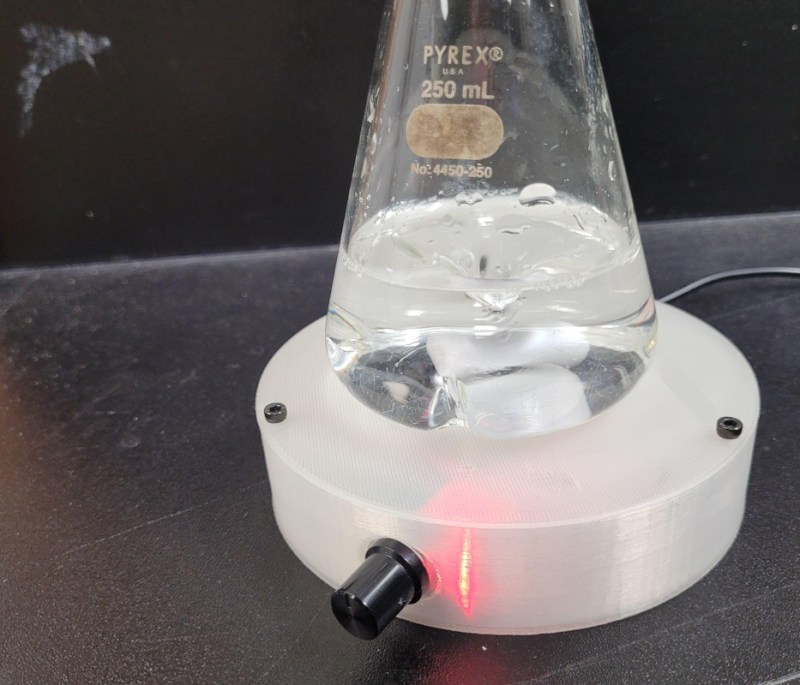Magnetic stirrers are a core part of many chemistry labs. They offer many advantages for ensuring the effective mixing of solutions compared to other methods of stirring, including consistency, precise control, operation within closed systems, and of course, hands-free automatic operation. With so many reasons for employing a magnetic stirrer, it’s not too surprising that [Joey] would want one. He built his using 3D-printed parts rather than purchasing it.
The magnetic stirrer uses a 3D-printed enclosure for the base. Inside is a PWM controller which sends power to a small DC motor. A 3D-printed arm is attached to the motor, which hosts a pair of magnets. As the arm spins inside the enclosure, the magnetic fields from the magnet couple with the stir bar inside the mixture, allowing it to spin without any mechanical link to the stirring device and without any input from the user. [Joey] has also made all the 3D-printed parts for this build available on Printables.
While magnetic stirrers aren’t the most complicated of devices (or the most expensive), building tools like this anyway often has other advantages, such as using parts already on hand, the ability to add in features and customizations that commercial offerings don’t have, or acting as a teaching aid during construction and use. It’s also a great way to put the 3D printer to work, along with this other piece of 3D-printed lab equipment designed for agitating cell cultures instead.

















Nice build, but an overhead stirrer would be more practical because you could use it in conjunction with a hotplate or heating mantle.
Open on top doesn’t work if it has to be sterile. I use one to make yeast cultures for home beer making.
There are also commercial /lab grade hot plate stirrers that are pretty darn expensive new (hundreds) but can be found used from the usual places.
The el-cheapo stir plates usually use some manner of modified CPU fan as the rotating element and I’ve had medium success with them.
What I really want to find is an actual shaker table from a lab that’s moving. That is definitely best way to shake and agitate a 4L Eflask, a common last size for lager yeasts.
Making home-made beer is more of a special case in chemistry or biology.
A very common and widespread special case that has it’s own specialty stores in most towns.
Many stir plates have heating elements built in or can support a mantle, it’s always from the bottom.
Overhead stirrers are often used in terms of viscosity and volume. Just a magnetic stirrer without the possibility to heat the medium makes not much sense.
I was curious how he made (materials, 3d printing without gaps, etc) the actual stirrer, the part that goes into the solution. Not a single word, looks like he bought it. Still a nice build.
Sealing a small magnet in a glass tube is an achievable diy project. Commercial stirrer beads are cheap and available though
Is there such a thing as an active stirring rod? Like a tiny PCB retrieving power from whatever field, wireless communication and all kinds of sensor for live chemical monitoring?
Kind of, applied science on YouTube made a demonstration of a “smart” stir bar
Yes, see here for a prototype by Applied Science:
https://hackaday.com/2023/04/20/a-temperature-sensing-magnetic-stir-bar/
They’re PTFE coated steel bars. Not much to manufacture, and they seem to go for less than $2 US per.
All mine are Teflon coated magnets, not steel bars. Did I miss something?
(Disclaimer: I’m a software hacker, so excuse my hardware ignorance.)
Why have a rotor at all? Directly drive the magnet with the coils…?
It’s probably cheaper to use a motor than orthogonal coils driven with sin/cos waveforms of variable frequency. It would be a much more elegant solution though.
Because that is more work, materials and expense. Super simple to drive a motor, more complex to phase a set of coils. Occam’s rule of invention: always go for the simplest solution that solves the problem.
That is the way that the big name brands do it.
Phil Barrett is probably correct that the coil design and drivers are more complex for a DIY build than a motor+magnet build. (And I’d like to add that a physical design is easier for DIY troubleshooting.)
I’d also like to mention that the magnetic fields of most stir plates I’ve used aren’t all that strong. Usually that’s not a problem, bring the speed up gradually and the small fields will be enough to slowly accelerate the bar and keep it in lock-step. However, I’ve had plenty of experiences where some powdered additive clumps on the bottom and suddenly causes enough friction to overcome the weak field keeping the bar in lockstep… the bar stops spinning properly and instead starts rattling at some beat frequency of the coils, requiring the unit be turned off then started up slowly again (possibly with a bit of manual stirring and agitation to get the friction/viscosity back under control).
Many a time I have wondered whether I should just build a DIY solution like OP posted above with a beefy motor and the strongest Neo magnets I can find to overcome these situations where the stir bar just needs more torque to work seamlessly.
Hi!
I really appreciate your efforts. Keep sharing such informative stuff. Really amazing. Thank you.